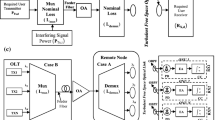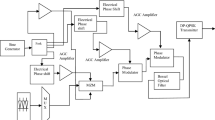Abstract
In this paper 40 Gb/s and 100 Gb/s Coherent optical Orthogonal Frequency Division Multiplexing (CO-OFDM) systems are studied to obtain the relation between the bit error rate (BER) and transmission link distance for a constant signal to noise ratio (SNR). Utilizing Dense Wavelength Division Multiplexing (DWDM) with 192 optical channels in C and L bands (1528.77 nm–1612.65 nm), data rates can theoretically reach up to 19 Tb/s (192∗100 Gb/s) using only one optical fiber core. In this research, we selected the same data rates with the IEEE standards published by IEEE Computer Society in 2010 and 2011. Results show the performance of the CO-OFDM system at different data rates and distances for one RF carrier and one optical carrier instead of 4 optical carriers used in IEEE 802.3ba.











Similar content being viewed by others


References
Djordjevic, I. B., & Vasic, B. (2006). Orthogonal frequency division multiplexing for high-speed optical transmission. Optics Express, 14, 3767–3775.
Shieh, W., & Athaudage, C. (2006). Coherent optical orthogonal frequency division multiplexing. Electronics Letters, 42, 5–589.
Xingwen, Y., Shieh, W., & Tang, Y. (2007). Phase estimation for coherent optical OFDM. IEEE Photonics Technology Letters, 13, 919–921.
Jansen, S. L., Morita, I., Takeda, N., & Tanaka, H. (2007). 20-Gb/s OFDM transmission over 4,160 km SSMF enabled by RF-pilot tone phase noise compensation. In Optical fiber communication conference OFC07.
Lowery, A. J., Liang, D., & Armstrong, J. (2006). Orthogonal frequency division multiplexing for adaptive dispersion compensation in long haul WDM systems. In Optical fiber communication conference OFC06.
Lowery, A. J., & Armstrong, J. (2006). Orthogonal frequency division multiplexing for dispersion compensation of long haul optical systems. Optics Express, 14, 2079–2084.
Shieh, W. (2007). PMD supported coherent optical OFDM systems. IEEE Photonics Technology Letters, 19, 134–136.
Xiang, L., Qi, Y., Chandrasekhar, S., & Shieh, W. (2010). Transmission of 44-Gb/s coherent optical OFDM signal with trellis-coded 32-QAM subcarrier modulation. In 15th opto electronics and communications conference OECC.
Yazgan, A. (2008). OFDM based chromatic dispersion compensation in fiber optic media. M.Sc. thesis, Karadeniz Technical University Department of Electrical-Electronics Engineering, Trabzon, Turkey.
Yazgan, A., Aydemir, O., Tugcu, E., & Simsek, C. (2009). Performance analysis of OFDM systems on AWGN channels. In Akademik Bilisim, Turkey.
Yazgan, A. (2011). Performance analysis and link design of longhaul coherent optical OFDM systems. M.Sc. thesis in electrical engineering. Halmstad, Sweden: Halmstad University Microelectronics and Phonics program.
Yazgan, A. (2011). The tradeoff between BER and link distance for a constant signal to noise ratio in coherent optical OFDM systems. In 34 international conference on telecommunications and signal processing, TSP 2011, Budapest, Hungary (pp. 126–130).
Yazgan, A., & Cavdar, I. H. (2011). Examination of the effect of fixing laser phase noise in coherent optical OFDM systems with different channel parameters. In 34 international conference on telecommunications and signal processing, TSP 2011, Budapest, Hungary (pp. 121–125).
Laude, J. P. (2002). DWDM fundamentals, components and applications. London: Artech house.
Stallo, C., Cianca, E., Mukherjee, S., Rossi, T., Sanctis, M. D., & Ruggieri, M. (2011). UWB for multi-gigabit/s communications beyond 60 GHz. Telecommunications Systems. doi:10.1007/s11235-011-9500-x.
Li, Y., & Stüber, G. L. (2006). Orthogonal frequency division multiplexing for wireless communications. Atlanta: Springer.
Soysal, B. (2004). High performance receiver design for OFDM based wireless communication systems. Ph.D. thesis, Karadeniz Technical University Department of Electrical-Electronics Engineering, Trabzon, Turkey.
Byun, D. K., Ki, Y. M., & Kim, D. K. (2007). Channel state-aware joint dynamic cell coordination scheme using adaptive modulation and variable reuse factor in OFDMA downlink. Telecommunications Systems, 36, 85–96.
Liu, Y., Song, Q., Guo, L., & Wang, X. (2011). Efficient scheduling algorithms for mixed services in wireless OFDMA system. Telecommunications Systems. doi:10.1007/s11235-011-9476-6.
Broadband radio access HIPERLAN type 2; Physical layer. Sophia Antipolis Cedex (1999).
McClellan, J. H., Schafer, R. W., & Yoder, M. A. (2003). Signal processing first. New York: Prentice Hall.
Matthew, N., & Sadiku, O. (2002). Optical and wireless communications next generation networks. Boca Raton: CRC Press.
Franz, J. H., & Jain, V. K. (2000). Optical communications components and systems. Oxford: Alpha Science.
Rajiv, R., & Kumar, N. S. (2002). Optical networks a practical perspective. San Mateo: Morgan Kaufmann.
Shieh, W., Bao, H., & Tang, Y. (2008). Coherent optical OFDM theory and design. Optics Express, 16, 841–859.
Bulow, H., Buchali, F., & Klekamp, A. (2008). Electronic dispersion compensation. Journal of Lightwave Technology, 26, 158–167.
Mynbaev, D. K., & Scheiner, L. L. (2001). Fiber-optic communications technology. New Jersey: Prentice Hall.
Goldflab, G. (2008). Digital signal processing techniques for coherent optical communication. Ph.D. thesis, University of Central Orlando, Florida, Department of Optics in the College of Optics and Photonics, Florida.
Paré, C., Villeneuve, A., Bélanger, P. A., & Doran, N. J. (1996). Compensating for dispersion and the nonlinear Kerr effect without phase conjugation. Optics Letters, 21, 459–461.
Killey, R. (2005). Dispersion and nonlinearity compensation using electronic predistortion techniques optical fibre. In The IEE seminar on communications and electronic signal processing.
Roberts, K., Li, C., Strawczynski, L., O’Sullivan, M., & Hardcastle, I. (2006). Electronic precompensation of optical nonlinearity. IEEE Photonics Technology Letters, 18, 403–405.
Lowery, A. J. (2007). Fiber nonlinearity mitigation in optical links that use OFDM for dispersion compensation. IEEE Photonics Technology Letters, 19, 1556–1558.
Lowery, A. J., Du, L. B. Y., & Armstrong, J. (2007). Performance of optical OFDM in ultralong-haul WDM lightwave systems. Journal of Lightwave Technology, 25, 131–138.
Shieh, W., Yi, X., Ma, Y., & Tang, Y. (2007). Theoretical and experimental study of PMD-supported transmission using polarization diversity in coherent optical OFDM systems. Optics Express, 15, 9936–9947.
Lowery, A. J., Wang, S., & Premaratne, M. (2007). Calculation of power limit due to fiber nonlinearity in optical OFDM systems. Optics Express, 15, 13282–13287.
Lowery, A. J. (2007). Fiber nonlinearity pre and post compensation for long optical links using OFDM. Optics Express, 15, 12965–12970.
Goebel, B., Fesl, B., Coelho, L. D., & Hanik, N. (2008). On the effect of FWM in coherent optical OFDM systems. In National fiber optic engineers conference, NFOEC.
Shokair, M., & Sakran, H. (2011). Performance of SDM/COFDM system in the presence of nonlinear power amplifier. Telecommunication systems. doi:10.1007/s11235-010-9393-0.
Al-kamali, F. S., Dessouky, M. I., Sallam, B. M., Shawki, F., & Abd El-Samie, F. E. (2011). Impact of the power amplifier on the performance of the single carrier frequency division multiple access system. Telecommunications Systems doi:10.1007/s11235-011-9439-y.
Ahmed, S., & Kawai, M. (2011). Interleaving effects on BER fairness and PAPR in OFDMA System. Telecommunication systems. doi:10.1007/s11235-011-9557-6.
Nazarathy, M., Khurgin, J., Weidenfeld, R., Meiman, Y., Cho, P., Noe, R., Shpantzer, I., & Karagodsky, V. (2008). Phased-array cancellation of nonlinear FWM in coherent OFDM dispersive multi-span links. Optics Express, 16, 15777–15810.
Goebel, B., Hellerbrand, S., Haufe, N., & Hanik, N. (2009). PAPR reduction techniques for coherent optical OFDM transmission. In International conference on transparent optical networks, ICTON09.
Tang, Y., Shieh, W., & Krongold, B. S. (2010). Fiber nonlinearity mitigation in 428-Gb/s multiband coherent optical OFDM systems. In National fiber optic engineers conference, NFOEC.
Du, L. B. Y., & Lowery, A. J. (2011). Pilot-based XPM nonlinearity compensator for CO-OFDM systems. Optics Express, 19, B862–B867.
Inan, B., Randel, S., Jansen, S. L., Lobato, A., Adhikari, S., & Hanik, N. (2010). Pilot-tone-based nonlinearity compensation for optical OFDM systems. In 36th European conference and exhibition on optical communication.
Mach, P., Bestak, R., & Becvar, Z. (2011). Optimization of association procedure in WiMAX networks with relay stations. Telecommunications Systems. doi:10.1007/s11235-011-9661-7.
Author information
Authors and Affiliations
Corresponding author
Rights and permissions
About this article
Cite this article
Yazgan, A., Cavdar, I.H. Optimum link distance determination for a constant signal to noise ratio in M-ary PSK modulated coherent optical OFDM systems. Telecommun Syst 55, 461–470 (2014). https://doi.org/10.1007/s11235-013-9801-3
Published:
Issue Date:
DOI: https://doi.org/10.1007/s11235-013-9801-3


